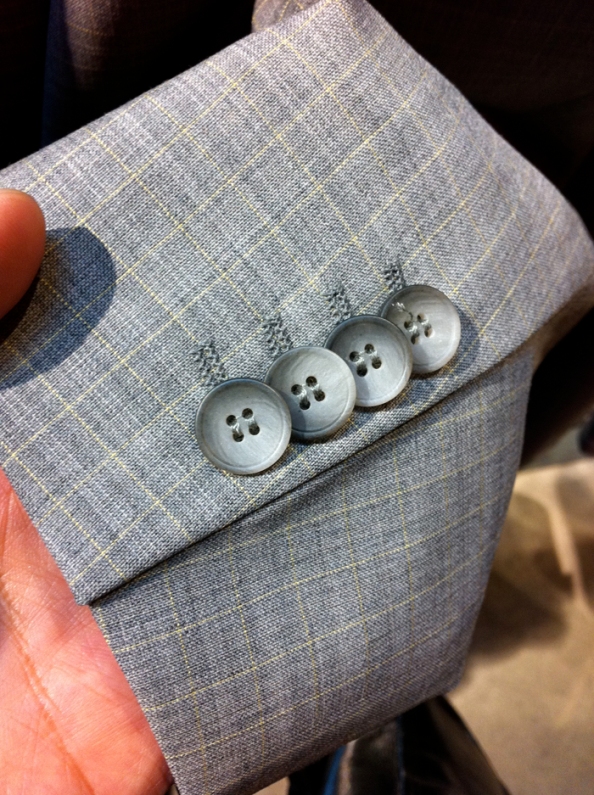
During my travels in East Europe, a visit to Hugo Boss Berlin revealed a travesty: Non-working sleeves on their suits.
It’s winter time and during a recent cold (weather-wise, the people are friendly) trip to East Europe, I walked into a Hugo Boss boutique in Berlin if only to check out the latest collection. Know what I found? Hugo Boss has done away with working buttons on the sleeves and that’s outright sacrilegious- It looks like it’s a real working sleeve but after a closer inspection, the eagle eyed (or gay) will notice that you’re trying to cruise by on a suit that’s subpar (though still real value for money) for a Monsieur.
How to buy a Good Suit
Here’s how to buy a good suit- Rule 1. Go visit Ermenegildo or Canali. I jest (but when in doubt, refer to Rule 1). Seriously speaking, every Monsieur should look for these key attributes in a suit.
- The cloth: You’ll want something sturdy yet resilient (wool 120s and 200s). Flannel is classic but a tad warm for summer time so look for cotton or seersucker. During winter, flannel rocks infinitely.
- The shoulders: You don’t want to look like a quarterback in your suit so avoid anything that looks like padding. Go with natural shoulders that slope gradually. If you happen to be a gym fanatic, chances are you’d need to see if the cut fits you without making you look Hulk-esque.
- Working sleeves: The buttons should work preferably. Yes, not many people use them but it’s a mark of distinction and keen eye for detail that differentiates The Monsieur from your average gentleman. Even then the buttonholes should be handsewn and serious tailors will ALWAYS make sure they work.
- Handstitched edges: Hand-stitched edges create a slight ruffle mostly evident in the lap pocket of a jacket. It’s hallmark of a superior suit.
- Luxurious interior: One of the most reliable indicators of quality, elegant linings and piping inside a jacket with fabric edged internal pockets are a reliable indicator that your tailor knows his stuff.
- The canvas: It’s the layer of cloth between the jacket’s exterior and lining. This attribute is key, consider it the foundation for a good suit; The canvas helps maintain a jacket’s natural shape over time. Most (cheap or mass produced) suits have their canvas fused which is a synthetic interlining machine heated until it sticks to the exterior. A properly canvased suit (and one that will last you till death) is one that can be pinched between the bottom two buttonholes revealing three layers to your deft fingertips. Alternatively, a less douchey or snobbish move would be to just ask the sales person.
- The silhouette: It should fit tight but not too tight. In the words of Dolce and Gabbana, “tight enough so that you can feel the fabric”. In the words of James Bond’s armourer Q, “tight enough so that you don’t raise hands too quickly in surrender.”

Danny W.
June 18, 2011
Article loses all integrity after starting with a knock against off the rack suits which don’t have working button holes. Everyone knows that functional cuffs are a pain in the dick to tailor around. The jacket shown in the picture illustrates the common trend, which is to sew the button holes shut and affix the buttons; this allows two things: 1. Your tailor can simply hem the sleeve and remove the 4th button, and reaffix further up. 2. If you can get away with an alteration of about 3/4″ or less, then the tailor can very easily rip the stitch on the button holes and the cuff seam, and then make the buttons function. This doesn’t involve too much, and is a very common tailoring request on a jacket with the features shown here.
I did manage to keep reading this garbage, and when the writer starts in with
Flannel is classic but a tad warm for summer time so look for cotton or seersucker.
you quickly realize that this person is a goddamn moron. “Ok, so you don’t want wool, so you definitely should just go for cotton, or seersucker.” This is horrible advice. Read any amount on summer suit fashion and you’ll realize that you can obtain tropical weight wools, or that many wools in the 100’s-120’s are good for year-round. Cotton and seersucker make a statement; they are not the only alternative to flannel.
Shoulders, the author says you should go with no padding. This is also garbage advice. Yes – too much padding is a no-no, but none at all makes it a much more casual jacket. The shoulders should accent your build and should more importantly fit from seam-to-seam. A padded shoulder that falls on the right point on each shoulder will look better than a natural shoulder that is 2 inches too wide.
The words on the canvas, well, its a gross over simplification and someone who wants can do the research.
Overall, this article gets a -10. The monsieur should look elsewhere for style advice.